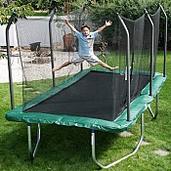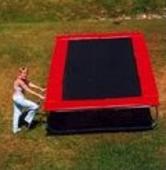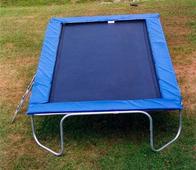Since I made this site, almost every other call is about someone sking if I can help them replace their springs. Listen, 99% oft these brands that are needing spring replacements I never even heard of the brand. It's usually some cheap trampoline thats from China and its not my problem. Why can't they just call the manufacture? Oh, that's right, they don't have a number on their site and its a number calling to China.
Please, if you have a cheap trampoline that needs spring replacments, I do not sell them. I don't get involved with springs that wear out or snap just after the 1 year warranty period.
Spring Warranty Issues
“Why do you have to replace springs�
Break: This is rare, but can occur and is worth mentioning. Some springs have snapped right away or after  few months and I don't recommend changing that spring but replacing al lthe springs. This is usually from a cold spot or crack in the medal. A good spring should last at least 10 years even with heavy jumpers against breaking. Make sure that the lenght of time they say their spring is warrantied against breaking is in WRITING. OR DO NOT BUY THEIR TRAMPOLINE
Premature Overstretching: This is very common with the low tensile springs. It's easy to tell if the spring is prone to over stretching by seeing if the spring "at rest" without any tension or pulling on it. Take it by the end and wave it back and forth. Let it flop all around. Look for the spread. Some will spread less between the coils and others you won't barely notice any space inbetween. Most of thte cheaper springs will have coils that don't close tightly together. If the coils are spread out you can see through the spring coils. A spring will have a maximum travel distance. There is no guessing on which spring will give the deapest bounce. People should know this if they don't want to by a lemon spring that will piss them off when they ahve to replace all the springs when the trampoline is out of warranty. The traveling distance before over stretching is determinted by the following factors. It took me a while to get this information. No one knew. It is by the original tension that the spring arecoiled with, the diameter of the wire used, and the diamter of the spring itself, and the most import thing the length of the spring, over all including the hook.
Then their are more detailed such as if it is 100% US steel or it is an alloy of different medals. Some are double dipped in a shiny silver alloy, for example, and the outer dipping has a higher melting point and stays cooler and draws the heat to the surface so the gray part (middle) of the spring stays cool so it doesn't over stretch. One company double dips their springs in this alloy twice. I have never had a spring break or lose tension. I personally have one of theirs and after 7 years, the bounce feels identical to a brand new set of springs. See my videos.
Initial Tension: The tension the springs are coiled with determines how tightly the coils will stay together. The original tension also helps give the spring strength so it won't overextend itself. The tighter the initial tension (IT) of the springs, the more weight that will be needed to overcome this tension and extend the spring. For heavy people or multi users all jumping at the same time, springs with higher tension can handle this more safely. Ask about the heaviest safe weight handling if you plan on having heavy weights on your trampoline. Make sure you know the heaviest rating as to not go against the weight rating in their warranty. Note that if a company rates their springs for 5 years and you put too much weight on them, good luck getting a free replacment. They can usually tell the cause of the breaking or premature stretching when they look at your spring for warranty replacement. Many people lie and say it happened but in actuality it was their fault.
NOTE:Â The diameter of the spring also affects initial tension. The tighter the diameter, the more IT, however travel is further reduced as each spring has less wire in it. This is why I have my quiz and ask all these questions. I recommend totally different spring types based on the answers I get.Â
Spring Travel:Â (Based on 2 springs of equal length but with differing diameters, the one with the larger will have more wire in it). Having the highest carbon steel also plays a big factor in how deep the person can travel in the mat and the number of free bounces it will give. A 10 inch spring can have over 20 feet of wire put into the spring and another 10 inch spring can have 16 feet of wire. This is another thing that I didn't read on any manufactures site. Most of the budget trampolines that have 7 inch springs or less have about 10 feet of wire or less. They usually have a small diameter too.
The larger the diameter of the spring the more the spring will travel giving a deeper bounce but the problem is that most are low carbon, not double dipped to keep it cool, not digitally tuned springs which is the latest advancement in springs.
Most springs that are low quality gain too much spring travel too soon and is not warrantied for replacement. Most of the sprigns that are complained about mostly are springs that are 1 inch or below in diameter. The springs that are 1 1/3 inch inches in diameter are rarely complained about.
​If you want a spring that will not gain too much spring travel makign it hard to overcome and gain free bounces, look for a higher diamter spring with high carbon. Springs that are low carbon steel will usually be way way cheaper.
Having a larger diameter basically adds about a third more wire. Its kinda like having an extra spring for every 2 springs on the trampoline. Having this also gives a different feel and ballistic impact to the bounce.
Scam: The wider the diameter, the longer the travel. Note that if IT falls with wider diameter springs, so be cautious of wide springs made with thin wire or coiled with significantly lower IT (anyone can test this at home by spreading the springs apart with your fingers. To do this test more accurately you can by suspending the spring at one end and attaching weights to the other end to see how much weight it takes to spread the spring. NOTE: shorter springs and springs with smaller diameter coils will have a harder impact and will be much more likely to bottom out when nearing/exceeding the weight capacity.
Hook Damage
I get called more about this problem with trampolines that are punched or drilled framed for for spring attachment. Springs that hook directly into the frame can often have their hooks bent out if the springs are depressed too far. This is due to the bottom of the coil colliding with the tube frame, where most of the deflection is transferred to the hook and can stretch and bend it out of shape. This usually happens when a people bounce and land heavily near the edge of the mat. The maximum possible spring deflection happens when a large force is concentrated in close to only a few springs. Now some companies are adding features to decrease hook damage frum happening.
Most common feature-
Tapered Ends: Some springs are tapered at the ends that adjust to the person's weight. BEWARE: some springs are tapered and once the tapered ends that are coiled for higher tension the belly of hte spring stretches out the rest of the spring goes down hill. Many eople think that their springs are responsive that is until 6 months laterwhen the springs tapered ends over stretch and go bunk. This is the cheap way of increasing the IT (initial tension) for those that are impressed at the first bounce period or the first few months. By this time you can't get your money back. The problem with t his on the cheaper springs (not the expensive tapered springs that are high carbon thoughout) is when the cheap springs give a deep bounce the first few months or even a year and the hook doesn't have enough carbon to withstand the deep bounces and the hook breaks on these tapered springs. Note that you cant just buy another spring, you gotta change all of them if you want even resistance thoughout.
A little more expensive to make but worth it:
Offset Suspension: This is a Suspension method that offsets the springs from the frame which prevents the usual contact between the spring and the tube frame and helps eliminate any hook damage. The main type is a spring where the coiled section ends early and a long hook extends out to attach to the frame. I still don't like type as I feel it is a way of getting around the problem so that a punched or drilled frame rail can still be used. The drawback of this type is because it usually in very small coiled springs as much of the spring’s overall length is mostly the extra-long hook. (hooks don’t bounce..coils do). The method I like best for suspension is a corrugated rod type where more medal is welded in to the frame where the springs will be attached instead. These are usually found on the most expensive trampolines. Increased cost comes from more time engineering the rods and the extra cost for steal and the extra cost for shipping a heavier trampoline.
This is for people that don't want holes drilled in their frame who can pay extra for a wider and thicker railing. People have the choice between getting drilled holes where the hooks go in and welded in steal where the spring won't wear out the hole edges and after a while leak in water and rust the frame.
Take the Trampoline Quiz based on your needs
...because they all said they have the best quality and bounce
1-877-336-7890
Open from
8am till 10pm
Rectangle-Trampolines-Reviewed.com
1-877-336-7890
Open from
8am till 10pm




